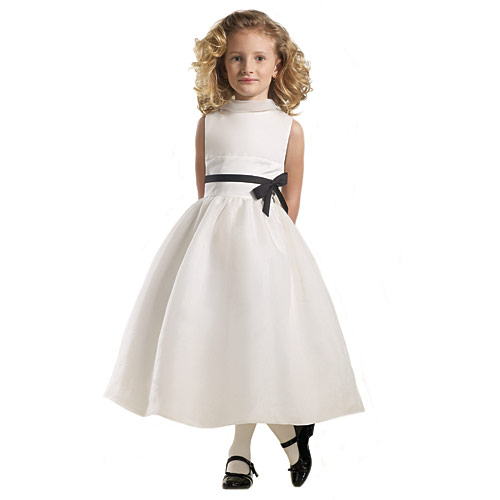Spend time with Joan Calabrese, and it’s quickly apparent that designing feminine frocks for the special moments in a girl’s life is her passion. Calabrese has marketed her line of elegant dresswear for more than 30 years—and it all started over a fortuitous dinner at her home. Tom Marotta, then vice president of couture at […]
Spend time with Joan Calabrese, and it’s quickly apparent that designing feminine frocks for the special moments in a girl’s life is her passion. Calabrese has marketed her line of elegant dresswear for more than 30 years—and it all started over a fortuitous dinner at her home. Tom Marotta, then vice president of couture at Saks Fifth Avenue, took note of the beautiful dresses her daughters were wearing. Calabrese had whipped up these garments to her own exacting specifications, as she did for all of her own children’s clothing. Shortly thereafter, the Joan Calabrese line was born.
“I’ve been interested in design as long as I could remember. My mother said as soon as I could hold a pencil I was drawing costumes and people,” the designer recalled. These early doodles eventually led to a high-end girls’ collection that has been carried at top department and specialty stores across the country. Given the price points that reach upwards of $500, however, many shoppers could only dream about owning a piece. When imitators began sprouting up selling garments at lower price points, Calabrese got her wake-up call. Eventually, she decided to beat those competitors at their own game and set about finding a wholesale partner for her more moderately priced offerings. This search lead her to bridal manufacturer Mon Cheri, and as owner Steve Lang and Calabrese tell it, the union is still in its honeymoon phase—one that neither party expects to end anytime soon.
From its inception in 1991, Mon Cheri aimed to be a leader in the wedding industry. Brides quickly became smitten with the company’s bold use of color in wedding dresses, a move that catapulted the brand to the forefront. Since then, Mon Cheri has remained vigilant in its quest to fill a bride’s every need. Three years ago, the company added the Joan Calabrese for Mon Cheri division of flower girl and communion options to round out its selection, which had grown to include mother-of-the-bride, prom and party dresses.
The match between Joan Calabrese and Mon Cheri has been a blissful marriage for the designer, wholesaler and retailers alike. For Calabrese, the Joan Calabrese for Mon Cheri collection provides a way for her to offer exquisite designs that fit into the typical mom’s budget. Meanwhile, Mon Cheri gets bragging rights for having landed a designer whose name resonates in the industry. And the label’s retailers—which span children’s boutiques, wedding salons and upscale department stores—enjoy a collection that provides the sophistication and elegance their customers demand.
Lang, for one, is thrilled. “The aesthetic of Joan’s collection is equal to that of an art exhibition,” he said. “With her fine attention to detail and finishing touches, each piece is a work of art.” Although Calabrese studied fashion illustration at the Pennsylvania Academy of Fine Arts, she never had formal design training. She credits her prolific design abilities to staying open-minded. “For the designers that are the most creative, it’s a never-ending process. You’re turned on all the time,” she added, noting that her inspiration can come from anything. “There are triggers that happen when your mind is open. Because I am a visual person, I respond to the triggers, and it all comes out when I’m sketching.”
This season, the Joan Calabrese for Mon Cheri collection continues to answer retailers’ needs with the addition of infant dresses, tween styles and more plus-size offerings. These new categories continue to showcase the designers’ singular aesthetic. “For me, what works is something that is a cut way above everything else that’s out there,” Calabrese said. “I think that is how you survive.”
How did the relationship with Mon Cheri come about?
Joan Calabrese: I found myself copied really badly over the years. One person literally took one of my catalogs and knocked off probably every dress in it. Unfortunately, in America you don’t have much protection, and you’d have to have a lot of money to fight [back]. But I have to thank those [imitators], because one day I woke up and said, “I’m tired of designing for the rest of the industry. I’m going to design a lower priced collection myself.” I did my research and found Mon Cheri. Steve Lang is a very bright man, and I decided it was the company for me. They’re a wonderful team to work with. We had instant chemistry.
Steve Lang: When you think of fine children’s wear, you automatically think of the name Joan Calabrese. The decision to work with her on this collection was a no-brainer—she’s simply the best. Joan’s reputation in the industry and [among] generations of women adds a timelessness and legendary feel to the collection. You know a “Joan” dress when you see one.
What is your design philosphy?
JC: It’s not my intention to give people more of what’s out there. I intend to bring something new to the table, something more fabulous. I take classics and add the twist of what’s going on in the market today. I am very inspired by au courant designs. It’s very important to be inspired by the way the trends are going. Tween dresses are the most trendy. The younger you get, the more classic the dress gets. It’s my business to take that classic shape and reinvent it in terms of detail, fabric choice and color.
What types of stores carry the line?
SL: Our stores are 60 percent children’s boutiques, 30 percent wedding shops and 10 percent department or other stores. Children’s boutiques are the strongest segment, since they carry the entire range of Joan’s styles, from baby to flower girl to first communion to tween. Bridal stores generally only carry flower girl dresses, which I believe allows for missed sales opportunities.
JC: The high-end department stores are buying the Mon Cheri line even though the price point is very affordable. When I started this, if you’d said to me that Neiman Marcus, Saks and Nordstrom would buy this line, I would have said “I don’t think so.” But Neimans is going to buy the line, it’s already very successful at Nordstrom and Barneys has purchased some segments. It gets down to the everyday people who, in this economy, are not in any position to spend crazy amounts of money on their child’s flower girl or communion dress, but nevertheless they want something spectacular. We are giving them spectacular, but the price is affordable. Our average wholesale prices are $70 to $80. The range is from $49 to $130.
Who is the Joan Calabrese for Mon Cheri customer?
SL: Our customers are moms who want an heirloom-quality dress their daughters can pass down to future generations at an affordable price that won’t break their budget. This consumer wants the design, fit, use of fabric and detail Joan is known for at a moderate price point. Joan Calabrese shoppers look for her classic dirndl skirts, unique color combinations and use of 3-D flower accents.
How has being a part of a bridal wear company influenced the looks of the girls’ line?
SL: Joan works closely with Mon Cheri’s bridal designer, Martin Thornburg, to create flower girl and special occasion dresses that complement but don’t mimic our bridal gowns. Rather than simply design miniature versions, Joan takes certain details from the bridal designs and incorporates them into her dresses in an age-appropriate manner. It’s important to her for a little girl to look like a little girl in her designs.
JC: I’m influenced by the bridal industry, but I’m not looking to do a miniature gown for a 5-year-old. I look at what the bridal designers are doing so that I can be inspired for the kids and so both lines will work together going down the aisle. Years ago we used to do lots of color, but today brides really like the idea of an ivory or off-white flower girl dress that goes with the color of the bride’s gown. They may want to introduce color as a sash, so we do offer that in quite a few styles. Dirndl skirts, princess dresses, A-lines—we like to make sure all of the shapes are in our collection.
How do you design for the different age ranges?
JC: We have to respect the fact that kids today are exposed to so much more than a few years ago, even. We have to make sure that the [tweens] don’t look babyish, so my dresses are not going to be the typical little-girl dresses. I’m designing dresses that are more hip and the kind of things that teenagers would like. We want feedback from our clients, because [consumer tastes] change all the time. When I first started, the mother made the decision and that was the end of it. Now the child is very involved in the decision. It takes a lot of work to get into an 8-year-old’s head. The only way to do that is to constantly observe, observe, observe. When I go to trunk shows, I get to see what resonates with them.
As you delve deeper into the tween category, how do you appeal to both moms and kids?
JC: It’s something of a compromise. I’m strong, however, in my belief system, and the folks here at Mon Cheri concur. We are not making sexy clothes for little girls, but we’re making things that can be perceived by the girl as being more grown up. We’re not making things that will have kids looking as though they’re 20 when they’re only 8. [For instance,] spaghetti straps are acceptable but no low-cut décolletage.
What are your top Fall/Winter ’10 looks?
JC: The No. 1 seller is a red taffeta Christmas dress with dimension, which we also offer in black. For babies, we used soft colors, but for older girls we used jewel tones, including some gorgeous platinum colors. For holiday, shoppers want strong statements of color. Black has also been popular. We have one black dress that has a sequin skirt with a jersey bodice and jet beading around the neck. Another important color is indigo blue. It was big last holiday and everyone did phenomenally well with it. We’ve also found purple and fuchsia to be good. Taffeta is the top fabric for winter, but flower girl dresses could be anything from taffeta to organza, tulle or matte satin. For older girls, soft fabrics that drape well are trendy. We have a lot of tulle ruffling and we use charmeuse because it’s soft and the older kids like that. The embellishments that work best are flowers, ruffles and beading. However, it’s not the typical big flower on the waist. We make flower details out of the dress fabric and add some beadwork, and it’s usually an allover thing. We’re finding the more we add in terms of embellishment, the better the reception.
How has the current economic situation affected the line’s design?
SL: No sacrifices have been made to the quality of Joan’s designs in order to make the product affordable for today’s economy. This value has been the cornerstone of the Joan Calabrese for Mon Cheri collection since its inception. Regardless of the state of the economy, moms can always expect an exceptional dress at a moderate price from this collection.
What advice do you have for retailers who are looking to increase their special occasion sales?
SL: Make sure that you have a well-stocked, broad variety of this collection in your store at all times. The collection cannot be well represented if you purchase less than the minimum of samples outlined each season. Also, promote the line as more than just a flower girl collection. Educate your customers through your website, advertisements and word-of-mouth that Joan Calabrese also offers special occasion party dresses, baby dresses, tween dresses and first communion dresses.
JC: If someone owns a store where these dresses are sold, the owners should make sure the staff members are educated on the dresses, what’s available to them, the options and how long it takes to order a dress. Otherwise the store could lose the sale. [Consumers] call us sometimes after being told they can’t get a style at their local store. Also, the sale has to be worth the salesperson’s time, so you might offer some special incentives.
—Caletha Crawford






Leave a Comment: